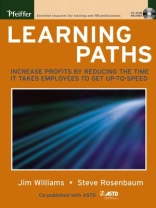Learning Paths is a down-to-earth practical resource that is
filled with illustrative examples, methods, techniques, strategies,
processes, and tools for making company-wide, real-time training
possible. Created to be flexible, the Learning Path approach can be
customized to fit your organization no matter what its type or
size. Learning Paths is divided into three sections:
The Learning Path Methodology: Walks the reader
through the major steps and strategies needed for building Learning
Paths.
Doing the Right Training: Offers a wide-range of
strategies, methods and techniques that can be targeted to the
training within a Learning Path and tied to an organization’s
particular business needs.
Do the Training Right: Shows how to ensure the training
within a Learning Path is delivered in the most cost-effective
manner and introduces methods for structuring training so that it
transfers to the job easily and effectively.
filled with illustrative examples, methods, techniques, strategies,
processes, and tools for making company-wide, real-time training
possible. Created to be flexible, the Learning Path approach can be
customized to fit your organization no matter what its type or
size. Learning Paths is divided into three sections:
The Learning Path Methodology: Walks the reader
through the major steps and strategies needed for building Learning
Paths.
Doing the Right Training: Offers a wide-range of
strategies, methods and techniques that can be targeted to the
training within a Learning Path and tied to an organization’s
particular business needs.
Do the Training Right: Shows how to ensure the training
within a Learning Path is delivered in the most cost-effective
manner and introduces methods for structuring training so that it
transfers to the job easily and effectively.
قائمة المحتويات
Contents of the CD-ROM.Foreword.
Acknowledgments.
Introduction.
PART I: THE LEARNING PATH METHODOLOGY.
Chapter 1: From Graduation Day to Independence Day.
Costly Delay.
Independently Productive.
How People Really Learn.
Learning Path Methodology.
The 30/30 Plan.
Summary.
Chapter 2: Getting Started.
Readiness Assessment.
Selecting a Function.
Learning Path Teams.
Holding a Kickoff Meeting.
Case Study: Part 1.
Summary.
Chapter 3: Measuring Time to Proficiency.
Finding Independence Day.
Ongoing Measurement.
Business Results.
Case Study: Part 2.
Summary.
Chapter 4: Mapping Learning Paths.
Research.
Preparation.
Mapping Session.
Case Study: Part 3.
Summary.
Chapter 5: Finding Quick Hits.
Out with the Old Stuff.
Tests and Milestones.
Pre-Hire.
Add Coaching and Mentoring.
Job Aids.
Implementation.
Case Study: Part 4.
Thirty-Day Report.
Summary.
Chapter 6: Accelerating Learning Paths.
Applying Learning Principles.
Principle #1: Managers Need to Be Trainers.
Principle #2: Reserve Classroom Time for Practice and Discussion.
Principle #3: All Self-Study Needs to Be Directed Self-Study.
Principle #4: Teach the Whole Job, Not Parts.
Principle #5: Require Mastery, Not Participation.
Principle #6: Connect to Business Needs.
Principle #7: Embrace Technology.
Principle #8: Quantity Versus Quality.
Principle #9: Use Design Templates.
Principle #10: Make Content King–Write It Down.
Principle #11: Use Proficiencies Versus Competencies.
Principle #12: Motivation.
Learning Path Evaluation Checklist.
Case Study: Part 5.
Summary.
Chapter 7: Transition and Maintenance.
Transition Planning.
Phased-In Approach.
Motivation and Communication Issues.
Maintenance Planning.
Learning Management Systems.
Reporting Results.
Summary.
Chapter 8: Managing Learning Path Projects.
Common Pitfalls.
Building Support.
Development Process.
Organization.
Planning and Tracking.
Reviews.
Pilot Tests.
Editing and Proofing.
Training for Learning Path Teams.
Virtual Teams.
Summary.
PART II: DOING THE ‘RIGHT TRAINING’.
Chapter 9: Building Proficiency Models.
Knowledge.
Skills.
Attitudes.
Competency Models.
Proficiency Models.
Learning Objectives and Activities.
Research Resources.
Summary.
Chapter 10: Developing Top Performers.
Top Performers.
Below Average Performers.
Experienced New Hires.
Ready for the Next Level.
Functions with Few Employees.
Manager/Leadership Paths.
Turnover.
Summary.
Chapter 11: Connecting to Business Needs.
Business Planning.
Role of the Learning Function Leader.
Planning Process.
Proficiency Planning Process.
Learning Path Planning Process.
Learning Paths and ROI.
Organizational Initiatives.
Summary.
Chapter 12: Capturing Content.
Presentations.
Electronic Capture.
Video.
Process Mapping.
Summary.
PART III: DOING THE ‘TRAINING RIGHT’.
Chapter 13: Selecting Training Methods.
Factor 1: Effectiveness.
Factor 2: Cost.
Factor 3: Speed and Flexibility.
Summary.
Chapter 14: Establishing Managers as Coaches.
Motivator.
Teacher.
Job Aids.
Debriefing.
Training Meetings.
Evaluation and Feedback.
Coaching the Coaches 217
Coaching Guide.
Summary.
Chapter 15: Building Directed Self-Study.
Definition.
Development Process.
Instructional Design Template.
Compliance and Motivation.
Summary.
Chapter 16: Creating the New Classroom Experience.
Introductions.
Team Building.
Practice Activities.
Real Situations.
Games.
Compliance.
Follow-Up.
Summary.
A Final Note.
Frequently Asked Questions.
Tool Kit.
Resources.
Index.
About the Authors.
How to Use the CD-ROM.
Pfeiffer Publications Guide.
عن المؤلف
Steve Rosenbaum is a consultant who has worked with America’s leading companies including Disney, Dupont, Ceridian, GE Capital Carlson Wagonlit Travel, and Allina Health Systems to help them design, develop, and implement creative training solutions.Jim Williams is a training and development leader with more than twenty years experience creating and implementing training solutions to support organizational change and growth initiatives first at IBM and then at General Electric.
They can be reached at www.Learning Path Consultants.com.
لغة الإنجليزية ● شكل PDF ● صفحات 334 ● ISBN 9780787975340 ● حجم الملف 1.9 MB ● الناشر John Wiley & Sons ● نشرت 2004 ● الإصدار 1 ● للتحميل 24 الشهور ● دقة EUR ● هوية شخصية 2456643 ● حماية النسخ Adobe DRM
يتطلب قارئ الكتاب الاليكتروني قادرة DRM












